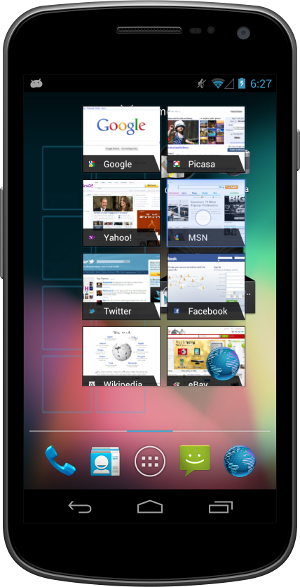Android 4.1, Jelly Bean: The world's most popular platform gets even better
Android 4.1, Jelly Bean, is the fastest and smoothest version of Android yet. Jelly Bean improves on the simplicity and beauty of Android 4.0, and introduces a new Google search experience on Android.
A smarter keyboard.
Android's dictionaries are now more accurate, more relevant. The language model in Jelly Bean adapts over time, and the keyboard even guesses what the next word will be before you've started typing it. With improved text-to-speech capabilities, voice typing on Android is even better; it works even when you don't have a data connection, so you can type with your voice everywhere you go.
Voice Search.
Sometimes you'd rather just speak your search query. Or just ask a question. Android lets you search the web with your voice, and it's convenient for getting quick answers on the fly. It speaks back to you and is powered by the Knowledge Graph, bringing you a precise answer if it knows it, and precisely ranked search results, so you can always find out more.
Enhanced Accessibility
New APIs for accessibility services let you handle gestures and
manage accessibility focus as the user moves through the on-
screen elements and navigation buttons using accessibility gestures,
accessories, and other input. The Talkback system and explore-by-

touch are redesigned to use
accessibility focus for easier
use and offer a complete set
of APIs for developers.
manage accessibility focus as the user moves through the on-
screen elements and navigation buttons using accessibility gestures,
accessories, and other input. The Talkback system and explore-by-

touch are redesigned to use
accessibility focus for easier
use and offer a complete set
of APIs for developers.
Accessibility services can link
their own tutorials into the
Accessibility settings, to help
users configure and use their
services.
their own tutorials into the
Accessibility settings, to help
users configure and use their
services.
Apps that use standard View
components inherit support
for the new accessibility
features automatically, without
any changes in their code.
Apps that use custom Views
can use new accessibility
node
APIs to indicate the parts of
the View that are of interest
to accessibility services.
components inherit support
for the new accessibility
features automatically, without
any changes in their code.
Apps that use custom Views
can use new accessibility
node
APIs to indicate the parts of
the View that are of interest
to accessibility services.
Resizable app widgets
Android 4.1 introduces improved App Widgets that can automatically
resize, based on where the user drops them on the home screen,
the size to which the user expands them, and the amount of room
available on the home screen. New App Widget APIs let you take
advantage of this tooptimize your app widget content as the
size of widgets changes.
resize, based on where the user drops them on the home screen,
the size to which the user expands them, and the amount of room
available on the home screen. New App Widget APIs let you take
advantage of this tooptimize your app widget content as the
size of widgets changes.
When a widget changes size, the system notifies the host app’s
widget provider, which can reload the content in the widget as
needed. For example, a widget could display larger, richer graphics
or additional functionality or options. Developers can still maintain
control over maximum and minimum sizes and can update other
widget options whenever needed.
widget provider, which can reload the content in the widget as
needed. For example, a widget could display larger, richer graphics
or additional functionality or options. Developers can still maintain
control over maximum and minimum sizes and can update other
widget options whenever needed.
You can also supply separate landscape and portrait layouts for
your widgets, which the system inflates as appropriate when the
screen orientation changes.
your widgets, which the system inflates as appropriate when the
screen orientation changes.
App widgets can now be displayed in third party launchers and
other host apps through a new bind Intent
(AppWidgetManager.ACTION_APPWIDGET_BIND).
other host apps through a new bind Intent
(AppWidgetManager.ACTION_APPWIDGET_BIND).










0 comments:
Post a Comment